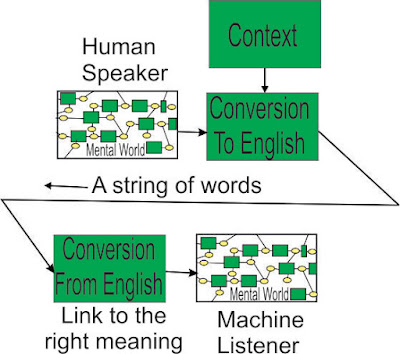Getting Connected
The example shows the amount of connection typical between
sentences.
Definition: a move by which a piece or pawn directly attacks the opponent's king. If the defending player cannot counter the attack, the king is checkmated
This is not simple. The second sentence is tied closely to
the first sentence, and would only be actioned when the move mentioned in the
first sentence occurred. That is, a dependent sentence.
The “opponent” in the first sentence is the “defending
player” in the second sentence. “the king” in the second sentence is “the
opponent’s king” in the first sentence, where the second “the” is Definition:
denoting one or more people or things already mentioned.
We should probably introduce “attacking player” doing the
checkmating. “move”, “piece” and “pawn” get chess meanings.
We will use “the king of the opponent” for “the opponent’s
king”, and the meaning of “of” – Definition: indicating an association between
two entities, typically one of belonging
We will use “a move that causes a piece or pawn to
immediately and directly attack …” until we are sure how to handle “by which”.
Definition: a (chess) move that causes a (chess) piece or
(chess) pawn to directly attack the (chess) king of the opponent. If the
defending player (the opponent) cannot counter the attack, the (aforesaid) king
is checkmated
“the attack” (noun) is pointed, through a clumping, to the
verb “attack” and its subject and object.
The links, such as “defending player” <-> “opponent”
or “king” <-> “king” are implemented with ISS operators – the objects on
either side of the ISS are the same object.
Supporting definitions
Move: Definition: a change of position of a piece
in a board game
King or
piece: Definition: a king, queen,
bishop, knight, or rook, as opposed to a pawn Domain:
Chess
Pawn: Definition: a chess piece of the smallest
size and value Domain: Chess
Checkmate: Definition: a check from which a king cannot
escape Domain: Chess
The MULTIPARENT3 operator is attached to every word, showing
part of speech, subcategory, and definition. It looks extravagant, but is only
represented once, and is used many times.
The IF_THEN operator, when used as Antecedent/Consequent,
works as follows:
· For the IF_THEN operator:
- A True coming in on Pin1 will cause a search on Pin2 if Pin3 is unknown (connections are undirected, and can be used in any way the machine wishes, at that instant).
- If a True is returned on Pin2, a True will be sent out on Pin3.
- A False coming in on Pin3, with Pin1 True and Pin2 unknown, will cause a False to propagate from Pin2.
- If a True comes in on Pin1, and Pin2 is True and Pin3 is False, an error will be raised.
The IF_THEN operator can also be used to provide a
definition:
Definition: If something is
banned, it has been stated officially that it must not be done, shown, or used
Note the presence of existential logic – “the defending player
cannot counter the attack”:
More evidence of how much the Unconscious Mind is managing.





Comments
Post a Comment